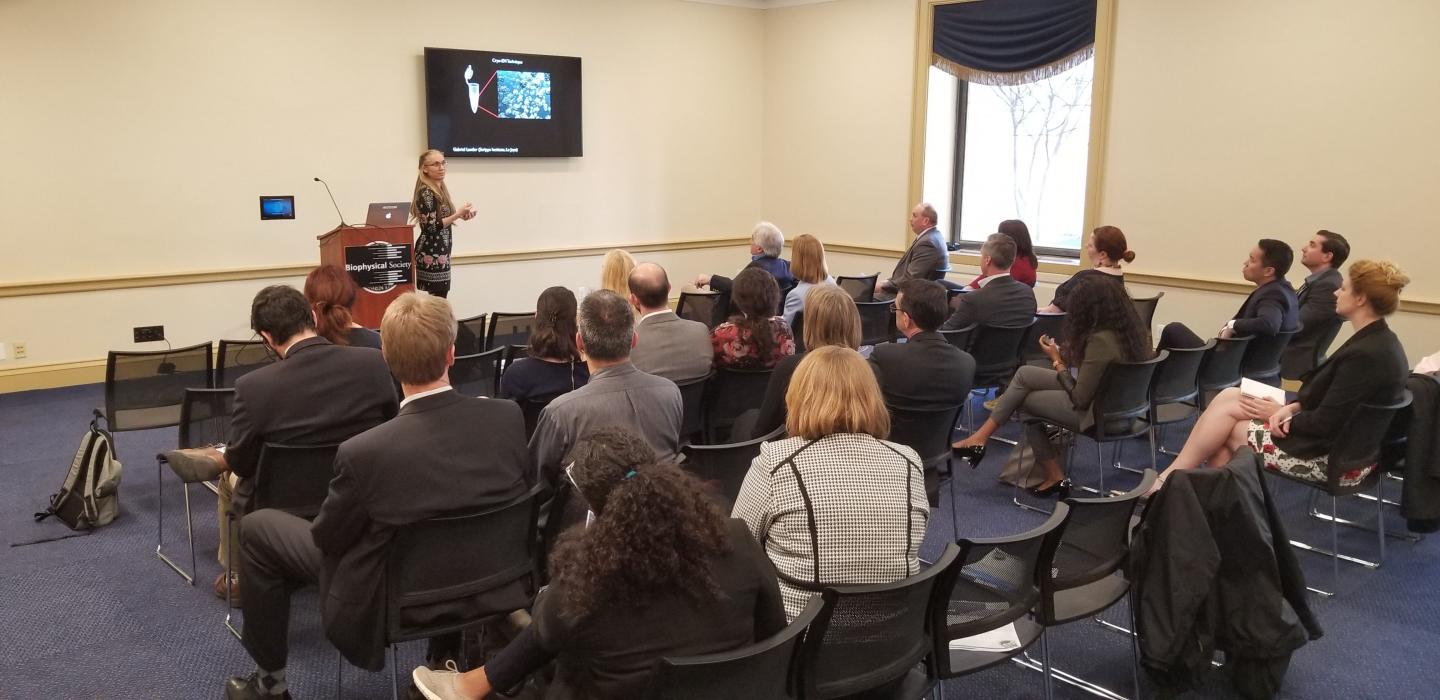
Credit: BPS
– On March 26, the Biophysical Society (BPS), in coordination with Congresswoman Barbara Lee (D-CA-13), hosted Dr. Eva Nogales for a Congressional Briefing titled the Cryo-EM Revolution. The briefing was sponsored by the American Society for Cell Biology (ASCB), JEOL.USA, the Lawrence Berkeley National Laboratory (LBNL), and Thermo Fisher Scientific, in partnership with the University of California – Berkeley (UC-Berkeley).
“We were pleased to host today’s informative briefing and are extremely grateful to our event sponsors and partners,” said Jennifer Pesanelli, Executive Officer, BPS. “Through sustained investments in basic science and technology development, the federal government continues to enable exciting scientific breakthroughs and possibilities. The story of Cryo-EM is the story of the successful partnership between researchers, academic and government institutions, and industry, which enables curiosity and job creation.”
Cryo-Electron Microscopy (Cryo-EM) is a biophysical technique that can be used to determine the structure of biological molecules. It allows researchers to create accurate, detailed, 3-D models of intricate biological structures at the sub-cellular and molecular levels. The process is fairly described by its name:
- ‘Cryo’: The process begins with a rapid cooling of a protein solution which contains the biomolecule researchers want to examine. When water is frozen normally, it forms crystalline ice. But extremely rapid cooling prevents water molecules from crystallizing, which helps to preserve the structure of the biomolecules.
- ‘Electron’: The frozen protein solution is then imaged with a beam of electrons.
- ‘Microscopy’: Microscopes magnify objects that cannot be seen with the naked eye. Just as a light microscope magnifies objects imaged with light, an electron microscope magnifies objects imaged with electrons. Using electrons instead of light, one can actually image atoms.
In 2017, the Nobel Prize in Chemistry was awarded to three scientists who played key roles in developing Cryo-EM.
“Recent technical developments have made cryo-EM a high-resolution technique within the reach of many structural biologists,” said Dr. Eva Nogales. “Government support for access to expensive instruments and large computational resources, and further technological development, from sample preparation to image improvement and analysis, will allow our scientists to generate a full structural and functional description of the repertoire of molecular machines that make up our and other biological organisms cells. Such fundamental knowledge in turn will provide the background needed for the rational and systematic design of disease-fighting therapeutics and biological based solutions for energy and environmental sustainability.”
Dr. Nogales’s briefing discussed the history of the technology, how it is used today, and shared some potential future policy recommendations to further its development. The federal government continues to support Cryo-EM technology through the National Institutes of Health’s Common Fund and the Department of Energy’s Office of Science.
The event coincided with the annual Biophysics Week, a messaging week that calls attention to the field of biophysics.
The Biophysical Society, founded in 1958, is a professional, scientific Society established to encourage development and dissemination of knowledge in biophysics. The Society promotes growth in this expanding field through its annual meeting, monthly journal, and committee and outreach activities. Its 9,000 members are located throughout the U.S. and the world, where they teach and conduct research in colleges, universities, laboratories and government agencies. http://www.
###
Media Contact
Sean Winkler
[email protected]
Original Source
https:/




